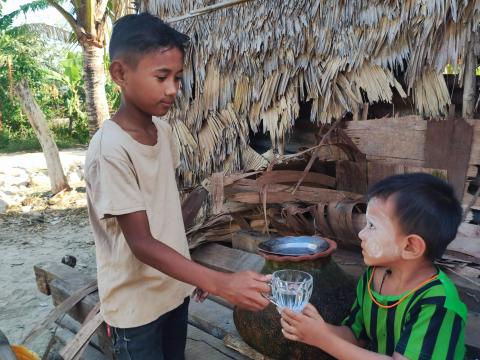Water: Life of the livings

Beginning of the tale
Kaung, a 10-year-old boy, lives with his mother, Su, and his 3-year-old younger brother. They live in a village in Paung Township, which is located in the southeastern part of Myanmar in Mon State. Kaung's father works in Thailand as a migrant worker and sends money home to support his family. His mother does not work outside the home and takes care of her two sons.
Kaung's village is situated near the Yangon-Mawlamyaing highway road and has around 300 households. Most of the people in the village are Mon ethnic, which is one of the main ethnicities in Myanmar. Because the village is close to the Thailand border, many family members, including Kaung's father, migrate to Thailand to work as unskilled laborers. Although farming used to be the main source of livelihood there, only fewer families now work in farming.
Water scarcity and its consequences
The villagers in Kaung's village rely on streams and rainwater for their water supply. During the rainy season, this works well. But in summer, the stream dries up, and the community members including Kaung’s family face difficulties in getting enough water and must go to the monastery or other water sources, which takes them about half an hour to reach. They sometimes have to buy water from street vendors who bring water from other sources and sell it in the village.
The worst thing is that people frequently dump their waste into the stream. Thus, water becomes dirty especially when it gradually dries out. Children often got sick mostly with diarrhoea, dengue fever, and other skin diseases. With many people using and drinking unsafe water, there is a rising concern about the potential outbreak of waterborne diseases. An estimated 914,000 people need safe WASH services, not just for general health, but to help protect themselves against the spread of COVID-19.[1]
Research shows that, in fragile countries like Myanmar, children under the age of five are 20 times more likely to die due to diarrhoeal diseases, often related to unsafe water, than in violent conflict.[2]
Inadequate healthcare facilities
“As we use that stream water, my children usually get sick of diarrhoea at least once a year. If that happens, I brought them to the Rural Health Center, but not to the hospital,” says Su, Kaung’s mother. “Until now, there was no major disease or death caused by using stream water, except diarrhoea,” she adds.
Only poor health facility is available in Kaung’s village. If children get sick, the parents take them to the nearest Rural Health Center (Zin Kyaik Town) where they travel for 5 to 6 kilometres from the village. When children face major health problems and need special treatment, the family travels for 40 kilometres to get to the town (Thahton Town) where they can find doctors (Pediatrician).
Kaung’s family challenges
“We have faced water shortage every year in summer, especially in March and April, when the stream dries up. It was very difficult for us to get enough water even for domestic use. We walked for 30 minutes to get water and return for 30 minutes. It was too tiring,” Su recalls.
“It is a bit tiring to fetch water from other sources but being an elder son, I am helping my mother to get water for cooking. It would be good for our family if we could get water easily, or within a short distance,” Kaung cites.
“My eldest son, Kaung is 10 years old and studying in grade 1. My youngest is only 3. Kaung always helps me to get water for domestic use.” Su shares. “Digging tube-well in our village is impossible, as groundwater is salty. It will be great if we have big rainwater collection tanks or ponds so that we would have no worries during summer.” Su wishes.
Kaung’s family relied on the only income from his father who supports them every month (about 250 USD). It is barely enough for the family. As the income covers just daily survival, the family faces difficulty when children get sick, especially when special care is needed.
World Vision Myanmar’s holistic plan
“Like Kaung’s Village, most of the villages in Paung Township face difficult access to clean water, especially in summer. According to the data from Township Health Department, diarrhoea is one of the most common diseases among children in Paung. Therefore, with funding support from New Zealand, Paung Area Program plans to address water issues by implementing Health & WASH activities in line with Health Technical Programmes. We will conduct a WASH need survey, explore possible water sources, and create sustainable water points for the communities. We will also establish and strengthen water user groups,” shares Moe, Paung AP Manager.
Communities in Paung, including Kaung’s village, still lack health and nutrition knowledge, in addition to inaccessibility to clean water. World Vision Myanmar started its assessments and design process in 2019. It will continue its presence in Paung to implement community development activities in collaboration with the local authority, concerned departments, and community members. WVM will ensure to provide the communities to get access to clean drinking water, and health facilities. The health referral system will also be strengthened. To promote the well-being of children, WVM will empower the most vulnerable children and families by strengthening their capacities and supporting the families’ technical skills in Livestock breeding and Agriculture farming to generate family income.